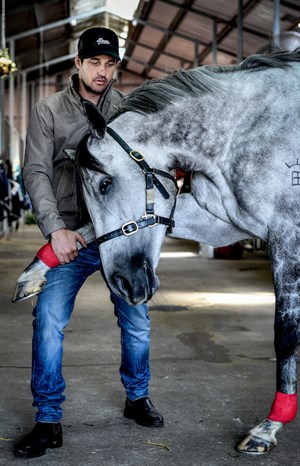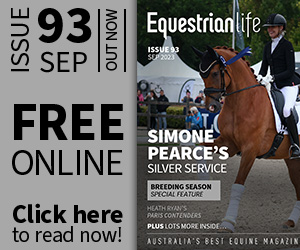|
This article has appeared previously with Equestrian Life (2015). To see what's in our latest digital issue, click here.

Tom with one of his favourite patients, star mare Catkins, who raced for the Chris Waller stable.
© Brendan Esposito/Fairfax Media
Ask the Physio: Does my horse have back pain?
Words and photos by Tom Simpson
The question I get asked most often is, “Does my horse have a sore back?” Back pain is a common cause of poor performance, yet it is often misunderstood and mismanaged.
AS AN EQUINE Physiotherapist, I founded Equine Performance Therapy in 2009 after completing my masters in animal physiotherapy after first qualifying as a human physiotherapist. Based in Sydney, I practice in both racing and performance stables and I am very lucky to have clients like Gai Waterhouse, Team Godolphin, Chris Waller, Team Hawkes and Team Snowden, not to mention the legendary late Bart Cummings, and of course his grandson James. In the performance industry I regularly treat elite dressage and showjumping horses.
The number one question that people ask me is, “Does my horse have a sore back?” or “How do I help my horse if it has a sore back?” Back pain is one of the most common causes of poor performance yet often poorly understood, mismanaged or even worse, ignored.
Clinical signs of back pain vary, however, some common presentations may include a “dipping” of the back with rider or saddle application, pain on palpation (i.e. when you touch the back), a reluctance to roll, bucking or swishing the tail under saddle, a reluctance to collect and, in some cases, a disunited canter.
If you are concerned that your horse has back pain, I strongly encourage you to do two things. First, consult a veterinarian. Your vet will assess the degree of intervention required and if or when physiotherapy is appropriate. Back pain can have a variety of causes so I cannot stress enough that, if misdiagnosed, you could waste a significant amount of time and money.
I would also encourage any rider to have a professional saddle-fit performed. A correctly fitting saddle is vital to performance. It is essential for the saddle to be adaptable, because when the horse changes shape the saddle must be able to adapt with it. When I treat a horse it is my job to follow a horse’s progression, and the choice of saddle fitter should be acknowledged and approached in the same way.
I know from experience how I am affected if I have back pain and your horse is no different. I thought that for this issue I would share some great stretching exercises that I strongly recommend become part of your daily routine.
Safety is the highest priority at all times. Note carefully the positioning of both myself and the horse in these photos to ensure the best possible position for both of you. Watch your horse and how it communicates with you; it will quickly let you know if it is enjoying it or not. That feedback is invaluable for knowing the end point that you should take the stretch to. Look for lips, eyes and ears!
Stretch 1: Forelimb stretch
This particular stretch is my favourite, and more often than not will be your horse’s as well. Some horses will either do this themselves prior to exercise or will learn to do it from you. Do not be alarmed if you hear a “pop” of the shoulder joint. This is simply a gaseous release inside the joint capsule and is not painful. And, no, you did not just put their shoulder back in!
Hold for 30-60 seconds and perform two or three times each side.

Stretch 1: Forelimb stretch.
Stretch 2: Downward horse (thoracolumbar stretch and core stability exercise)
This is an invaluable exercise for any horse performing any athletic discipline as it provides a fantastic stretch of the soft tissue structures associated with the thoracolumbar spine, provides flexion of the spine itself to assist in preserving or restoring range of motion, and it also strengthens the core stability muscles that are extremely important in supporting the back.
Perform five times and hold for 5-10 seconds. You can go back as far as your horse will let you.

Stretch 2: Downward horse.
Stretch 3: Hamstring stretch
Probably the hardest stretch to do, but there are good tips to make it enjoyable for yourself and your horse. Most importantly, elevate the leg, support the hock and just stand there. This will give the horse confidence before performing the stretch. I find the closer to the horse I am the more comfortable we both are. Then apply a gentle force and direct the hoof towards the carpus (knee) with the horse’s hoof on your leg. This is the safest position for this stretch.
Hold for 30-60 seconds and perform two to three times each side.


Stretch 3: Hamstring stretch.
Stretch 4: Hip flexor and quadricep stretch
Be careful not to be aggressive in this stretch, let the horse tell you how far to take the stretch. It may require several attempts before he/she understands what you are asking of them. Like the forelimb stretch don’t be surprised if your horse is quick to learn the value of this exercise and stretches it him/herself. Do not be alarmed though this is great!

Stretch 4: Hip flexor and quadricep stretch.
Best of luck in applying these exercises and I hope you enjoy the rewards of your hard effort, as I am sure your horse will.
For more info follow Physio Tom on Twitter: ep_physio, Facebook: Equine Performance Physio or Instagram: epphysio
READ THE LATEST NEWS ARTICLES HERE

|

